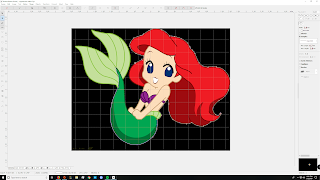PLP Project
Rationale:
My rationale for this
project came from the fact while the new rollout of OCP (Official Camouflage
Pattern) uniform for the United States Air Force. I wasn’t wanting to pay a
premium to order patches and our unit needed some patches for our new uniforms.
So I took it upon myself to learn the craft of machine embroidery to make
patches. While researching and getting started I realized how intricate this
process may be and I could maybe save some time for others who are wanting to
also make embroidery designs starting from scratch and learning how to digitize
their own designs. Crawl before we can walk, that’s how this course will be
designed.
Audience:
The intended audience for users who are just get starting
and want to digitize their designs and get them from a picture, to a stich
count, then onto the machine, and finally onto fabric. So they can see their
creations come to life.
Outcomes and
Assessments:
My outcome for this course for users to be able to digitize
any design they want so they can create any sort embroidery design they want.
1.
Understand what digitizing is and why it’s
important to creating your embroidery designs.
2.
Demonstrate how to digitize by picking a design
and starting the process with your software (Embird).
3.
Once finished check your design by using the
preview mode and seeing how your stitch looks like.
4.
Transfer the file to a USB and bring it over to
your embroidery machine.
5.
Embroider!
Assessments:
Digitize! – Digitizing can be a bit difficult, especially if we are new and staring at a daunting menu that you are unfamiliar with. When assessing how well we understand digitizing, a simple assessment can be done with a small project and using a small selection of tools that will be laid out.
Embroider! – When putting your digitized product on your
fabric, sometimes the results can be not what you imagined. The final
assessment will consist of completing a project with less than 3 errors on your
design.
Reflection – When it comes to any sort of adult learning,
reflection time is critical to understand where mistakes were made and how we
can improve those. This also allows us time to relate this experience to our
lives and possibly help us in the future when it comes to future projects. Zhou
and Brown have noted that the reflection period is important when its new
learners are taking in new material. “The learner will
then begin to formulate concepts and hypotheses concerning the experience
through discussion as well as individual reflection (discussion afterwards, but
also could be done with journaling)” (Zhou, Brown, 2015).
Insights:
The first insight
I had was how this course would be taught. In person, online, webinar, or even
a YouTube video. I found that the best way for a course such as this would just
be online with submission platform for the digitized product as well as a
picture of the final embroidery on fabric. This can make it, so it can be done
on free time, you aren’t wasting gas to drive for an essentially 1-3-hour
lesson, and you can work from the comfort of your own home at your own pace.
The second
insight was the challenge of trying to figure out what learning theory best
applied to what I’m trying to do. Over the course of this semester I have found
that I am mostly siding with behaviorism. I feel this way because after I
created my first couple of designs, I saw the feedback and positive results I
got from others when I showed them the designs. The pleasure reward system in
my brain fired and I know I wanted to see more positive feedback like what I experienced.
This allowed me to slowly creep into bigger designs until I did my final
project for my daughter which took about 4 hours digitizing and 2 hours embordering.
The immediate consequence of that project resulted in a smile I will never
forget from my oldest.
Reflection:
Going back to the beginning of the class and when I started my project I knew that I was not only thinking of this as a learner perspective, but also from the educator role. Which in turned, to me, meant I would have to figure out a way to relate some theories to my course. I feel that while the traditional behaviorist theory can fit into here well. I decided to take it a step further than that and relate the social cognitive theory to it. They are similar theories in a sense, but SCT takes it further by letting the student process what they saw, how the felt about it, and a take away from their experiences. With that it lets them create their own conclusions/ideas from the experience. From this course, I feel that would be the most beneficial. Because sure the students can watch a YouTube video and recreate any design they see. Once they start taking the designs and manipulating it to their liking is when the students are creating their own ideas on the project of embroidery. That’s when I’ll feel that the course was successful and why its so relatable to SCT.
Zhou, M., & Brown, D. (2015). Educational Learning
Theories. Retrieved from https://drive.google.com/file/d/1viBDJFnpzGN_gS-KLXpnlWGaXq5SQpp0/view
For reference: here is the digitizing process and the final results of the project I made for my daughter









Adlai, this is incredibly beautiful. I am sure she loved it.
ReplyDelete